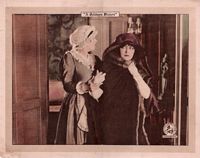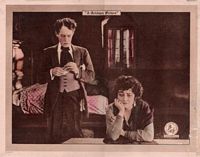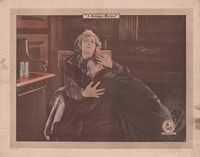

Madame X (1920) Goldwyn Pictures Corp.; Distributor: Goldwyn Distributing Corp. Director: Frank Lloyd. Scenario: J.E. Nash and Frank Lloyd. Camera: J.D. Jennings Cast: Pauline Frederick, William Courtleigh, Casson Ferguson, Maud Louis, Hardee Kirkland, Albert Roscoe, John Hohenvest, Correan Kirkham, Sidney Ainsworth, Lionel Belmore, Willard Louis, Cesare Gravina, Maud George. 7 reels.
A copy of this film is held by George Eastman House (35 mm). This was the most famous of her roles during her lifetime, and she toured with it on stage later in her career. Another film version was made in 1916, and it has been filmed again many times since.
Click thumbnails for larger view
A pressbook, courtesy of Derek Boothroyd. I also put up a PDF copy in the Internet Archive
 |
 |
 |
 |
Two tinted lobby cards courtesy of Derek Boothroyd
 |
 |
 |
| Jacqueline Floriot | Pauline Frederick |
| Louis Floriot | William Courtleigh |
| Raymond Floriot | Casson Ferguson |
| Rose Dubois | Maud Louis |
| Dr. Chesnel | Hardee Kirkland |
| Cesaire Noel | Albert Roscoe |
| M. Valmorin | Correan Kirkham |
| Laroque | Sidney Ainsworth |
| M. Robert Parissard | Lionel Belmore |
| M. Merival | Willard Lewis |
| Victor | Cesare Gravina |
| Marie | Maud George |
Frank Lloyd directed this Goldwyn version of Alexandre Bisson's classic. He also collaborated on the adaptation. It is evident therefore that his digit occupies considerable space in this pie. And therefore, also, he must be ready to stand or fall by the production's reception. The picture is excellent as a feature and all that, but one cannot help feeling the result might have been even more satisfying.
One will grant "Madame X" isn't an easy play to film. The big courtroom scene with the young barrister pleading for the defendant--who unknown to him is really his mother, held on the charge of murder--is indirectly dramatic at best as far as "action" is concerned. In the play it was the part of the personator to compel attention. Even such emotional adept as Pauline Frederic, who is starred, cannot sit in the prisoner's box through many minutes of footage and writhe and convulse the features convincingly enough to supersede that concrete something so essential to picture success, and so absolutely necessary to sustain interest--"action." Where a better job might have been done is in this courtroom scene where something virile, action visualization (by means of flashback) could have been interpolated to relieve the monotony of the youthful attorney's verbal plea. Frankly, any patron viewing that scene cold bloodedly, minus the natural sympathy for the star, will find little convincing reason there to free a woman who was seen by many to have murdered a paramour on what appeared to be slight provocation. Her statement that she killed "to save somebody she loved from disgrace" was not borne out by weighty evidence as to the identity of this personage and while the audience is advised as to this, the judge and jury are not apprised as far as the audience can see.
But at that, what average audience is so exacting as all this. They take things at face value. Miss Frederick is the star. Her leering, wanton, absinthe-drugged expression is not one to incur natural sympathy except for the fact contributory and unjust circumstances caused it all. At any rate, it was this deviation from the glorified heroine to something mundanely human to that accounted for the play's international success and should not lose its power of attraction in the screen form.
It is an emotional role for the star and she realizes its possibilities more capably and sufficiently in the "twenty years" later portion than in the introduction. And strange to say, too, Miss Fredericks presents a more youthful appearance here than in the former section. If the The Skirt were here to view the picture no doubt that authority on habiliments les femmes would have found fault with her headgear, although poor lighting might have been at fault for the mature expression imparted.
In the support William Courtleigh, as the star's husband of former years, looked sufficiently reserved to suggest the possibility of having started his wife on the road to ruin because of a misunderstanding. Casson Ferguson, as their son, grown-up and a practicing attorney, was rather youthful for such a part, but capable. His might have been a sub-star part as far as the trial scene is concerned if it had been played majestically enough. Sidney Ainsworth did his Lorogue, a polished underworldsman, convincingly. For the rest, Willard Louis as M. Merival, a blackmailer, looked calmly suave and self-satisfied enough to have been a villain despite his portly build, twinkling eye and mustache, and is a decided relief from the usual sleek and slender collection of villains. What distinguishes Mr. Louis is that not so long ago (if memory is not playing tricks) he was performing in comedy effusions of exceedingly light texture.
The balance of the support is high grade and capable.
"Madame X"
Pauline Frederick Does Splendid Work in Goldwyn Screen Version of Famous Stage Drama.
Reviewed by Mary Kelly.
So nearly does the Goldwyn screen version of "Madame X" in its emotional intensity approach human experience that the spectator forgets art, forgets drama, in the face of absolute realism. Insistently it plays for sympathy and it gets sympathy to a degree of which few pictures are capable. If possible, it is too real, too heart-rending at times in its protracted revelation of a mother's misery and suffering. There is a little comedy relief and there are a few light moments, but these are fleeting and a trifle forced. Except for this slight deficiency in the matter of shading, the picture is a rare work of power and art.
To Pauline Frederick falls the role of "Madame X," who is banished from home, husband and son early in her married life by an unfortunate circumstance which brands her as untrue in the stern eyes of her husband. She is reduced to the lowest misery. Twenty years later she kills a man to save her son from being informed of the truth about his fallen mother. In the trial the son, unaware of his mother's identity, is the council for the defense, and wins her case.
Miss Frederick plays the mother role tragically, passionately, and does not hesitate to sacrifice her natural attractiveness for the sake of her characterization, which is necessarily an unbeautiful one. Toward the close, however, her face expresses the beauty of sublimation that sorrow and suffering has brought. Casson Ferguson as the son and William Courtleigh as the husband have exacting, forceful roles to which they are fully equal.
The trial scene has been skillfully acted and directed. The meeting between mother and son is suspended until just the right moment and the climax is a real dramatic achievement. Patrons, both men and women, have expressed themselves as being very deeply moved by this photo-drama.
Cast:| Jacqueline Floriot, or "Madame X" | Pauline Frederick |
| Louis Floriot | William Courtleigh |
| Raymond Floriot | Casson Ferguson |
| Cesaire Noel | Albert Roscoe |
| Helene | Correan Kirkham |
| M. Parissard | Lionel Belmore |
Drama by Alexandre Bisson.
Scenario by J.E. Marsh
Directed by Frank Lloyd.
Length, Seven Reels.
The Story:
Jacqueline Floriot has been forbidden by her husband, public prosecutor in Paris, to re-enter their home, although their small son is dangerously ill. Having grown desperate with anxiety she comes to the house unseen by him and is admitted by a servant. But M. Floriot discovers her and refuses sternly to allow her to see Raymond, the child, reminding her of the act that caused their separation.
This circumstance consisted of an unfortunate meeting a year or two before, between Jacqueline and a friend of her husband's who made love to her and was overseen by Floriot. The latter refused to hear any explanations but, believing the worst of his wife, banished her.
Upon their second meeting in his house, he forces her from his doors forever. Her life becomes a wretched, dishonorable experience and she sinks lower and lower into a sad condition of degradation. She is found twenty years later by Laroque, a disreputable Frenchman traveling in South America. He consents to take her back to Paris as his "life's companion." After arriving, her history becomes known to two rascally prosecutors, whose profession is demanding hush money for concealing scandals. Laroque is let in on the profits and proceeds to call upon Floriot, who has not risen to a very high position in Paris.
Jacqueline, frenzied for fear her son will learn the truth about her and have his career spoiled, threatens to shoot Laroque. He laughs at her and proceeds to go regardless, whereupon she kills him.
She is taken to the prison and for months refuses to talk, calling herself "Mme. X." Then the trial. Unaware of the old woman's identity, Raymond has been made her attorney. The sight of her inspires him with pity, which becomes love as the trial proceeds. His eloquence and sympathetic plea win for her her freedom. She learns who he is before he finishes, but still refrains from disclosing herself. But Floriot has seen her and recognizes her and tells the truth to his son. Mother and son meet a short time before death ends her suffering.
Program and Exploitation Catchlines: "Madame X"--She Preferred to Be Nameless. After Years of Degradation She Wanted to Save Her Son from Knowing Her Past. She Made a Mother's Supreme Sacrifice--She Stayed Out of His Life.Exploitation Angles: Give this unstinted advertising. It is a big, even great picture. Sell it on its potentiality as a "mother love" picture. Explain that the stellar role is entirely different from the usual Pauline Frederick type of role, that it is a vitally human role with an appeal as wide as life. Tell it is from the Bisson stage hit.
Big Feature is Goldwyn's "Madame X"
One must admit that the main attraction at the Capitol this week is the Goldwyn feature, "Madame X" which has Pauline Frederick as the star. Not only is the picture decidedly interesting but it has been given a splendid production.
...The story of the famous melodramatic stage success is too well known to repeat. It deals with a woman who leaves her husband and baby son only to go from bad to worse through the use of absinthe until at length she is brought into court to be tried for the murder of the man who has caused her downfall. Her own son is appointed to defend her though neither knows the other's identity, and through his eloquence she is acquitted, but only to come to her death before she has left the court. Pauline Frederick as Gabrielle [sic], who is later the unfortunate Madame X, has a fine opportunity to reveal her dramatic force and does so wonderfully. The supporting cast is also of first rate quality.
Alexandre Bisson's "Madame X," as transferred to the screen, is, as might be expected, a work of many words, and many scenes meaningless without them. It is not so much a play in moving pictures as a printed play with animated illustrations. But it is probably that most of those who go to the Capitol Theatre this week will find it interesting, because its illustrations are good, well composed and competently directed by Frank Lloyd, and excellently acted in by Pauline Frederick, William Courtleigh, Casson Ferguson, Sidney Ainsworth, Lionel Belmore, Willard Louis, Cesare Gravina, Maud George and the others of the cast.
Also, the story has something in its favor. Artificial as it is, unlikely as its people and situations are, it is, nevertheless, dramatic in its crises, and, as told, is persuasive. On the supposition that the story says "If such things and such people could be, they would be thus," there would be few to disagree. This story, as many no doubt know, is about a woman who is turned from her home and child by a jealous husband, and so "driven," according to the accepted view of the case, into the obscurity of an underworld from which she emerges twenty years later as the murderer of a man who wished to injure her son. When brought to trial she is defended by the son, who learns that she is his mother only after he has obtained her acquittal by a fervid plea for mercy. And then the story wins its own hypothetical case by going resolutely to its only possible happy ending. In many movies the woman, who in twenty years had become a drug addict and lost all her ined [sic] instincts except those arising from the embers of love for her child, would have been miraculously restored to physical and moral health so that she might again become the wife of her husband and the mother of her son. But "Madame X" is truer than that to itself--and, appropriately and happily, the woman dies at the point where the future becomes impossible.
Pauline Frederick deserves credit twice for her impersonation of Madame X, first for undertaking the play at all a part offering so few of the "attractions" that interest most "stars," and second for the way she plays it. Whatever the story has of life, however persuasive it is, is due as much to her performance as to everything else combined. In makeup and acting she gives Madame X definiteness, and, by her restraint avoids the ever present danger of letting her become simply a burlesque tragedy queen. This characterization is one of the best pieces of work the talented Miss Frederick has done.
Pauline Frederick gives a brilliant performance in this ultimate "mother-love" film. The film is a bit draggy in spots and Casson Ferguson as her son is comically inept, but Frederick commands the screen in all of her scenes, from the rejected wife to the doddering absinthe addict, to the agonized wreck of a mother in the courtroom. Of particular interest is the way she often holds her hands or her veil over her mouth, to let her eyes do all the acting. The film is far superior to the 1929 version.
Print viewed: Eastman House 35mm print screened at the Pacific Film Archives.
More information on this film can be found in the following source:
Magill, Frank N., ed., Magills Survey of Cinema: Silent Films. Englewood Cliffs, N.J.: Salem Press, c1982 (entry on Madame X by DeWitt Bodeen).
Last revised, January 1, 2014